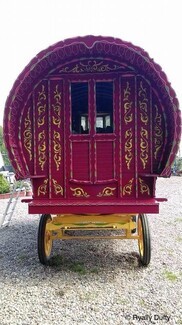Paint Your Waggon

Romany Gypsy Ryalla Duffy, author of the book ‘Woodsmoke and Waggons’, tells The Travellers’ Times about her traditional wagon painting skills. Amazing! What beautiful pictures.
Being Born in the 1950's and raised in the 1960's, I was fortunate enough to catch the tail end of 'waggon time'. When I was little our only home was a horse-drawn living waggon, so I grew up watching my Dad when he got his paint brushes out, to touch up a few chamfers and scrolls.
I enjoyed everything about paint - the colours, the texture, the smell, the way it could transform something from old to new, from mundane to marvellous. My Dad made do with a simple Rowney sable paint brush and a few tins of Humbrol or Japlac. In later years, when I moved to the yard at Selborne and many vans came in for paint jobs or restoration, my skills developed. Using sign-writing paint and the proper long bristled lining brushes made life much easier. 'Keeps' enamel was costly, but fit for purpose, it covered like a dream. Books of 23ct gold leaf were available for gilding - adding that extra dash of luxury for those with deeper pockets.

I enjoyed looking at the work of seasoned waggon painters: Jimmy Berry, Tommy Gaskin, Joe Barras. They'd tell of how they'd improvise, using blades of grass or snips of children's hair in place of a lining brush. I lapped up all this knowledge and stored it away for future use.
Early waggon painters tended to 'flash-up' the standard coach painting of the day. As time moved on the craft evolved into an art in its own right. Whilst every painter has their own style, common themes of decoration that embellished the scrolls and lining, included horses, vine work, fruit, birds, elaborate carvings and gold leaf as well as triple shading. Underworks and accessories were traditionally painted in a paler yellow or cream, whilst colours for the body favoured maroons, greens, reds and occasionally dark blue. Once the woodwork has been prepared and primed, subsequent layers of gloss are applied before skilled decoration is added. Finally, several coats of exterior varnish help unify the layers, as well as affording protection from the natural elements which all take a toll on the paintwork.
When my own family were young and we still travelled the roads full-time in a waggon, like my Dad, I'd get out my brushes and get to work - my workshop was the great outdoors too. I loved the way the brush danced with the paint, each needing the other in equal measure. Free hand scrolling takes a lifetime to master. The standard of artwork now, is higher than it's ever been and painters, particularly in the North East of the country, have taken it to a whole new level, a standard which I greatly admire. It puts my own humble efforts into perspective.

Waggon painting is now truly recognised as a work of art in its own right - and justly so. It's very satisfying seeing these traditional skills being handed down from one generation to another, for the enjoyment of many and long may it continue.
Woodsmoke and Waggons is published by Robert Dawson and can be ordered direct through its own Facebook Page https://www.facebook.com/groups/1442917789346546/?fref=ts or by contacting Ryalla Duffy direct on ryalla.duffy@hotmail.com